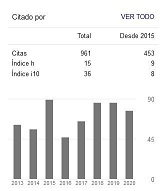Albendazole and Triclabendazole Used as Treatment for Fasciolosis in Sheep.
Resumen
The effects of Albendazole and Triclabendazole on 12 adult Pelibuey ovines infected by Fasciola hepatica in the province of Camagüey, Cuba, were evaluated. A reduction and fecal egg count test was performed. Two groups of animals were made for critical study. On day 0 (D0), the animals in group 1 were given Albendazole orally, and group 2 received Triclabendazole. The fecal samples were collected (rectal) on days 0 (D0), 14 (D14), and 28 (D28), after treatment. The McMaster technique was used for F. hepatica egg count using a ZnCl 2 solution (1.5 g/ml), at 10 eggs per stool gram. The groupʼs mean results first, and the egg reduction per cent later, were calculated. On D14, 98.17 % egg reduction was observed in group 1, and 79.58 % in group 2. However, on D28, group 1 underwent 33 % reduction, whereas group 2 experienced 90.39 %. The treatment using Triclabendozole was more effective for F. hepatica.Descargas
Citas
FAIRWEATHER ,I. (2005). Triclabendazole: New Skills to Unravel an Old(ish) Enigma. J. Helminthol., 79 (3), 227-34.
FAIRWEATHER , I. (2011). La reducción de la amenaza futura a partir de (hígado) golpe de suerte: realista perspectiva o de fantasía quijotesca. Vet. Parasitol., 180, 133-143.
FLANAGAN , A. M.; EDGAR , W. J.; FORSTER , F.; GORDON , A.; HANNA , E. B.; LANAGAN , A.; EDGAR , W. J. et al. (2011). Anthelmintic Activity of Artesunate against Fasciola hepatica in Naturally Infected Sheep. Veterinary Science, 88, 107-110.
LYONS , E. T.; TOLLIVER , S. C.; DRUDGE , J. H.; STAMPER , S.; SWERCZEK , T. W.; GRANSTROM , D. E. (1992). Critical Test Evaluation (1977-1992) of Drug Efficacy against Endoparasites Featuring Benzimidazole-Resistant Small Strongyles (Population S) in Shetland Ponies.
MAS -COMA ,S. (2005). Epidemiology of Fascioliosis in Sheep Endemic Areas. J. Helminthol., 79, 207-216.
MEZO , M.; GONZÁLEZ -WARLETA , M.;CARRO , C.;UBEIRA , F. M. (2004). Un ultrasensible ELISA de captura para la detección de coproantígenos de Fasciola hepatica en ovejas y el ganado con un nuevo anticuerpo monoclonal (MM3). J. Parasitol., 90, 845-852.
REINALDO , L.; PÉREZ RUANO , M.; BRITO . S. (2002). Fasciolose Bovine a Cuba. Etude Rétrospective a L´abatage et Analyse des Perdes par Saiseie de Folies. Revue Élev. Méd. Vét. Pays trop., 55, 31-34.
ORTIZ , P.; CERNA , C.; ROSALES , C.; CABRERA , M.; SOLANA , H. D.; SCARCELLA , S., LAMENZA , P.; VILLEGAS , F. et al. (2012). Administration of Triclabendazole is Safe and Effective in Controlling Fascioliasis in an Endemic Community of the Bolivian Altiplano. PLoS Negl Trop Dis, 6 (8), 1 720-2 012.
GONZÁLEZ , J. E. (1995). Evaluación económica de la Fasciolosis en la provincia Sancti Spíritus y valoración económica de las pérdidas ocasionadas. IV Congreso Nacional de Ciencias Veterinarias. La Habana, Cuba.
BORAY , J. C(1997). Chemotherapy of Infections with Fasciolidae. Immunology, Pathobiology and Control of Fasciolosis. Rahway, NJ: MSD AGVET.
LAVERDE L. (2007). Efecto del nosodes fasciolinum y del fármaco Triclabendazole sobre la oviposición de Fasciola hepática en bovinos. Tesis de Maestría. Facultad de Ciencias Veterinarias, Univ. Austral de Chile, Valdivia.
LEATHWICK , D.; MILLER , C.; ATKINSON , D.; HAACK , N.; ALEXANDER , R.; OLIVER , A. M.; WAGHORN , T.; POTTER , J.; S UTHERLAND , I. (2006). Drenching Adult Ewes: Implications of Anthelmintic Treatments Pre- and Post-Lambing on the Development of Anthelmintic Resistance. NZ Vet. J., 54, 297-304.
MOLL , L.; GAASENBEEK , G.; VELLEMA , P. y BORGSTEEDE , F. (2000). Resistence of Fasciola Hepatica against Triclabendazole in Cattle and Sheep in Netherlands. Vet. Parasitol., 91, 153-158.
OVEREND , D. y BOWEN , F. (1995). Resistance of Fasciola Hepatica to Triclabendazole. Austr. Vet. J., 72, 275-276.
Los autores de los artículos publicados en RPA retienen los derechos de autor de su trabajo, de marca y patente, y también sobre cualquier proceso o procedimiento descrito en el artículo, así como a compartir, copiar, distribuir, ejecutar y comunicar públicamente el artículo publicado en la RPA o cualquier parte de aquel siempre que indiquen la fuente de publicación (autores del trabajo, revista, volumen, número y fecha), pero están de acuerdo en que la revista publique los trabajos bajo una licencia Creative Commons.
![]() Licencia Attribution-NonCommercial 4.0 International (CC BY-NC 4.0)
Licencia Attribution-NonCommercial 4.0 International (CC BY-NC 4.0)






































